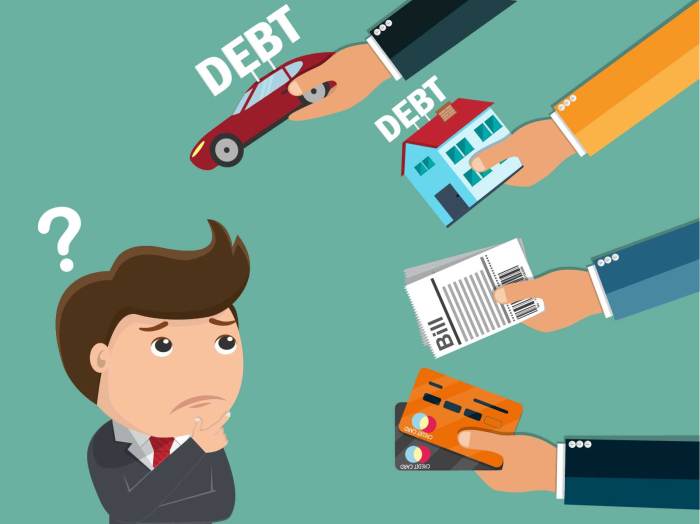
The crushing weight of student loan debt is a pervasive reality for millions, often hindering financial freedom and long-term goals. This guide explores legitimate pathways to alleviate or eliminate this burden without necessarily making direct payments. While complete debt elimination without any repayment is rare, several strategies, including government programs and legal avenues, can significantly reduce or even erase your debt. Understanding these options is crucial for navigating your financial future.
We will delve into the intricacies of federal loan forgiveness programs, income-driven repayment plans, and the Public Service Loan Forgiveness (PSLF) program. We’ll also examine less-common but potentially viable options like bankruptcy and strategic negotiations with loan servicers. This comprehensive overview aims to empower you with the knowledge needed to make informed decisions about your student loan debt.
Income-Driven Repayment Plans

Income-driven repayment (IDR) plans offer a pathway to manage student loan debt by basing your monthly payments on your income and family size. While they don’t eliminate debt without payments, they can significantly lower monthly payments, potentially making them more manageable and preventing default. However, it’s crucial to understand how they work and their long-term implications.
How Income-Driven Repayment Plans Function and Their Long-Term Effects
IDR plans calculate your monthly payment based on a percentage of your discretionary income—the amount remaining after subtracting certain expenses from your gross income. This percentage varies depending on the specific plan. Importantly, payments are typically lower than under standard repayment plans. However, the lower monthly payments often extend the repayment period to 20 or 25 years, potentially leading to a higher total amount paid over the life of the loan due to accrued interest. Forgiveness may be possible after a certain number of qualifying payments, but this forgiveness is taxable income.
Comparison of Different Income-Driven Repayment Plans
Several IDR plans exist, each with its own nuances. These include: Income-Based Repayment (IBR), Pay As You Earn (PAYE), Revised Pay As You Earn (REPAYE), and Income-Contingent Repayment (ICR). The differences lie primarily in the income percentage used to calculate payments, the eligibility requirements, and the specific forgiveness terms. For example, REPAYE generally offers lower payments than IBR, but it includes both undergraduate and graduate loans in the calculation. ICR often has higher payments than others and has less stringent eligibility requirements. Understanding these differences is vital for choosing the plan best suited to your individual circumstances.
Applying for and Enrolling in an Income-Driven Repayment Plan
The application process typically involves completing a form that requests details about your income, family size, and loan information. This information is then used to determine your eligibility and calculate your monthly payment. You’ll need to recertify your income annually to maintain your plan. The process is generally completed online through the student loan servicer’s website. You can find the specific application process on the Federal Student Aid website (StudentAid.gov).
Calculating Monthly Payments Under Various Income-Driven Repayment Plans
Calculating precise monthly payments under IDR plans requires using the specific formulas employed by each plan, which can be complex. These formulas take into account your adjusted gross income (AGI), family size, and loan balance. The federal government provides online calculators on the StudentAid.gov website and through individual loan servicers that can assist with these calculations. These calculators streamline the process, providing a personalized estimate based on your inputted information. It’s crucial to use the official calculators as the formulas are complex and precise calculations are essential for accuracy. Remember, these are estimates; your actual payment may vary slightly based on the servicer’s final calculations.
Public Service Loan Forgiveness (PSLF) Program

The Public Service Loan Forgiveness (PSLF) Program is a federal initiative designed to incentivize individuals pursuing careers in public service by offering loan forgiveness after 120 qualifying monthly payments. This program can significantly reduce or eliminate student loan debt for eligible borrowers, but understanding the requirements is crucial for successful application and forgiveness.
PSLF Program Requirements
The PSLF program has specific requirements that must be met to qualify for loan forgiveness. Failure to meet even one requirement can result in denial. These requirements fall into two main categories: employment and repayment plan.
Employment Requirements: You must be employed full-time by a qualifying government or non-profit organization. “Full-time” is generally defined as 30 hours per week. The employer must be a federal, state, local, or tribal government organization, or a non-profit organization that is tax-exempt under section 501(c)(3) of the Internal Revenue Code. Simply working for an organization with a public service mission isn’t sufficient; the employer itself must meet specific criteria.
Repayment Plan Requirements: Your federal student loans must be under an eligible Income-Driven Repayment (IDR) plan. This includes plans like Income-Based Repayment (IBR), Pay As You Earn (PAYE), Revised Pay As You Earn (REPAYE), and Income-Contingent Repayment (ICR). It is important to note that simply making payments on your loans is insufficient; those payments must be made while enrolled in a qualifying IDR plan. Consolidation of loans into the Direct Consolidation Loan program is generally required to be eligible, though some borrowers may already have Direct Loans.
Reasons for PSLF Application Denials
Many applications for PSLF are denied due to common mistakes. Understanding these pitfalls is essential for a successful application.
One frequent reason for denial is incorrect employment certification. Borrowers must obtain and submit an Employment Certification form (Form PSLF-Employer Certification) from their employer, verifying their employment and the hours worked. Inaccurate or incomplete forms are a leading cause of rejection. Another common issue is failure to consistently make qualifying payments under an eligible IDR plan for 120 months. Missed payments, even one, can significantly delay or prevent forgiveness. Finally, having the wrong type of loan can also lead to denial; only Direct Loans are eligible for PSLF.
Examples of Qualifying Professions
A wide range of professions qualify for PSLF. The key is employment by a qualifying employer, not the specific job title.
Examples include teachers in public schools, social workers in government agencies, nurses in public hospitals, military personnel, and employees of non-profit organizations dedicated to public service (e.g., environmental protection, public health, or legal aid).
PSLF Application Checklist
Before submitting your application, ensure you have gathered all the necessary documents. Missing documents will delay processing.
A complete application typically includes: Your Federal Student Aid (FSA) ID, a list of your federal student loans, documentation verifying employment with a qualifying employer (including the Employer Certification Form), and proof of enrollment in a qualifying IDR repayment plan.
Bankruptcy and Student Loan Discharge

Discharging student loan debt through bankruptcy is exceptionally difficult, but not impossible. The process is complex and requires a strong understanding of bankruptcy law and the specific circumstances surrounding your loans. Success hinges on demonstrating undue hardship, a high legal bar that necessitates a compelling case.
Student loan debt is generally considered a non-dischargeable debt under Chapter 7 bankruptcy. This means that simply filing for bankruptcy will not automatically eliminate your student loans. However, there is a legal pathway to discharge student loan debt through Chapter 13 bankruptcy, which involves a repayment plan, or through Chapter 7 bankruptcy if undue hardship can be proven. The latter, however, is significantly more challenging.
Undue Hardship Standard
The Brunner test is the primary legal standard used to determine undue hardship. This test requires demonstrating that: (1) you cannot maintain a minimal standard of living if forced to repay your student loans; (2) this state of affairs is likely to persist for a significant portion of the repayment period; and (3) you have made good faith efforts to repay your loans. Meeting all three parts of this test is extremely difficult, and proving “undue hardship” is a highly fact-specific determination, varying based on individual circumstances and the judge’s interpretation.
Legal Complexities and Challenges
Navigating the bankruptcy process for student loan discharge is incredibly complex. The legal standards are stringent, requiring meticulous documentation and persuasive legal arguments. Legal representation is virtually essential, adding significant financial burden to an already challenging situation. The process itself is lengthy and can be emotionally draining, requiring extensive preparation and potentially multiple court appearances. Further complicating matters is the potential for the lender to challenge the bankruptcy filing, leading to protracted legal battles. Successfully discharging student loans through bankruptcy often necessitates demonstrating a total inability to maintain a basic standard of living, even after exploring all available income-driven repayment plans and other options.
Case Studies of Successful Discharges
While rare, there are documented instances of individuals successfully discharging student loans through bankruptcy. These cases typically involve extreme circumstances such as debilitating illness, permanent disability, or a combination of factors demonstrating a truly insurmountable financial burden. Specific details of these cases are often confidential due to privacy concerns, but legal databases and bankruptcy case summaries may offer some insights into the types of situations where courts have found undue hardship. It is crucial to remember that these are exceptional cases, and they do not guarantee a similar outcome for others.
Steps Involved in Pursuing Student Loan Discharge Through Bankruptcy
The process of pursuing student loan discharge through bankruptcy is complex and requires careful planning and legal expertise. The following flowchart illustrates the general steps involved:
[Diagrammatic representation of a flowchart would go here. It would show the following steps: 1. Consult with a bankruptcy attorney specializing in student loan discharge; 2. Gather extensive documentation regarding income, expenses, and loan details; 3. File a bankruptcy petition (Chapter 7 or 13); 4. Attend creditor meetings; 5. Present evidence of undue hardship to the court; 6. Court ruling on discharge; 7. Appeal (if necessary).]
Final Review
Successfully navigating the complex landscape of student loan debt requires a proactive and informed approach. While completely eliminating debt without repayment is challenging, understanding the available programs and strategies—from income-driven repayment plans to potential bankruptcy options—is key. Remember to thoroughly research each option, carefully consider its implications, and consult with financial professionals for personalized guidance. Taking control of your student loan debt is achievable with diligent planning and a clear understanding of your rights and options.
Clarifying Questions
What is the difference between deferment and forbearance?
Deferment temporarily postpones your payments, and under certain circumstances, interest may not accrue. Forbearance also postpones payments, but interest usually continues to accrue, increasing your overall debt.
Can I consolidate my federal student loans to simplify repayment?
Yes, consolidating your federal loans into a single loan can simplify repayment by combining multiple payments into one. However, be aware that this might not lower your interest rate or shorten your repayment period.
What if my PSLF application is denied?
If denied, carefully review the denial reason and address any identified issues. You can appeal the decision, providing additional documentation to support your eligibility. Consider seeking assistance from a student loan advocate or legal professional.
Are there any penalties for missing student loan payments?
Yes, missed payments can lead to late fees, damage your credit score, and potentially result in your loans going into default, which has serious consequences.
